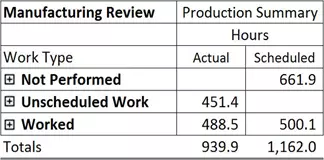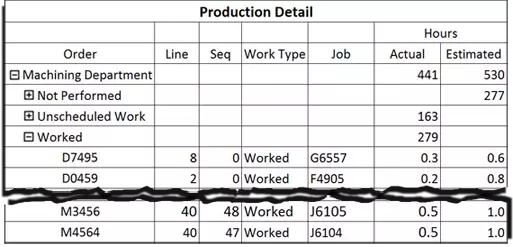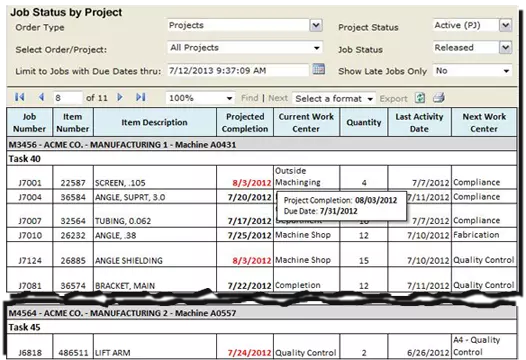For background on this particular project, please visit Activity Versus Achievement.
Situation ...
This engineer-to-order (ETO) designer, manufacturer, and assembler of sophisticated equipment uses their enterprise resource planning (ERP) system to plan – for costing purposes – materials purchases and usages, labor usage, and machine usage.
Problem ...
The company's products and services are in high demand, which stretched parts manufacturing past its limit. Even though labor and machine hours were planned by job, they were not being used to schedule specific technicians and machines. To better schedule these limited resources, the company needed to upgrade its ERP system by three major versions and reproduce highly customized functionality. Our client needed help getting the stalled system upgrade back on track, and then developing processes and reports to implement resource scheduling. The upgrade timeframe was very aggressive – the "go live" date was only five weeks after we began our work.
Solution ...
To get the system upgrade back on track, we provided them the experience and knowledge to:
- Keep both the client and value-added reseller (VAR) focused on the key issues and overall timeline.
- Explain to client personnel the implications of certain configuration decisions.
- Anticipate upcoming bottlenecks in system resources or personnel, and address them.
Once the system upgrade was successfully completed by the desired date, we moved on to help:
- Understand the scheduling methodology designed into the ERP system's production planning module.
- Work through, with client personnel, scheduling several example jobs using the ERP system.
- Design and develop summary scheduling reports to supplement the ERP system's reports, which were all at a very detailed level.
- Design and develop a supplemental application to take and hold snapshots of the planned schedule, allowing personnel to freeze and store the data for a particular plan.
- Design and develop the reports to compare actual production for the week against the snapshot of that week's plan.

Above, this summary-level report in the supplemental application compares stored snapshots of a planned schedule versus actual production. As this report shows:
- Of the 1,162 hours of work scheduled for week, 662 hours of scheduled work did not get done, while 451 hours of unscheduled tasks were worked.
- Had the 451 hours instead been used to work on the Not Performed tasks, about 70% of them could have been completed.
- For the tasks scheduled and worked, the actual hours were very close to the scheduled ones.
Above and below, both the summary-level and detail-level reports show three types of work:
- Not Performed reflects tasks scheduled for the week, yet did not get worked.
- Unscheduled Work reflects work done on tasks not on this week's schedule.
- Worked reflects tasks which had hours both scheduled and worked.

Above, this detail-level report from the supplemental application allows drill-down by department, type of work, project, and job. Managers in Scheduling and Production use this to keep everyone focused on the tasks to be completed this week.

Above, the Job Status by Project report allows users to query the data in various ways. When a task is projected to be complete after its required due date, the date is shown in red – hovering the mouse pointer over the date displays a pop up with the projected and required dates.
Results & Benefits ...
With our help, the client met their "go live" date to have all the modules required for base functionality. This provided them with a more sophisticated system, having improved data entry screens, query capabilities, and response time.
We then turned our attention to the scheduling process, successfully eliminating double entry into a separate job tracking system, and designing and developing the application to store the week's schedule. We also created reports to highlight:
- Interrelated constraints among the three parts manufacturing departments.
- Potential bottlenecks.
- Need for overtime work or outsourced production to address the bottlenecks.
Reporting actual versus planned production for the week now allows our client to:
- Understand the reasons behind major production misses, and work to reduce them in future weeks.
- Set and communicate expectations for parts being available for assembly, and for assembled products to be shipped to the customer.
Conclusion ...
The company has finally begun enjoying the benefits of the ERP upgrade – the up-to-date system provides them capabilities employees had been wanting for several years. With the improved scheduling, and related actual versus scheduled accountability, executives can better plan when new customer projects can be accepted, and rearrange schedules to meet frequently changing customer needs.
For More Information ...
To discuss how technology usage and business process improvements could be applied to the issues facing your business, call us at 336.297.4200 to schedule a no-obligation consultation, or click here to contact us online.





